Click on images to enlarge
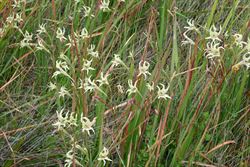
infestation (Photo: Trevor James)
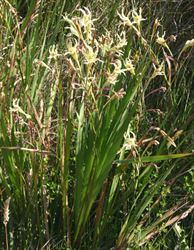
habit (Photo: Trevor James)
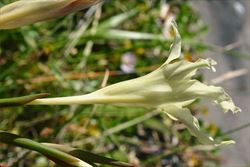
tubular flower from side-on (Photo: Trevor James)

close-up of flower (Photo: Trevor James)
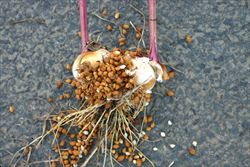
corms and cormils (Photo: Trevor James)
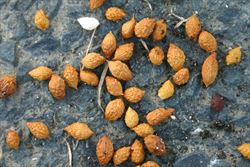
close-up of cormils (Photo: Trevor James)
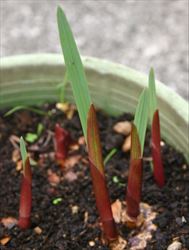
seedlings (Photo: Trevor James)
Scientific Name
Gladiolus undulatus L.
Synonyms
Gladiolus cuspidatus Jacq.
Family
Iridaceae
Common Names
gladiolus, large painted lady, large white Afrikaner, wavy gladiolus, wild gladiolus
Origin
Native to southern Africa (i.e. south-western Cape Province in South Africa).
Cultivation
Wild gladiolus (Gladiolus undulatus) has been cultivated as a garden ornamental in the temperate regions of Australia.
Naturalised Distribution
Widely naturalised in southern Australia (i.e. in Victoria, Tasmania, many parts of eastern New South Wales, the southern parts of South Australia and south-western Western Australia).
Also naturalised overseas in tropical Asia, New Zealand and the Caribbean.
Habitat
A weed of gardens, roadsides, disturbed sites, waste areas, riparian vegetation, swamps, wetlands, winter-wet pastures, drainage channels, shrubby woodlands, grasslands, coastal environs and estuarine mudflats in temperate regions.
Habit
An upright (i.e. erect) herbaceous plant usually growing 0.4-0.8 m tall, but occasionally reaching up to 1.4 m tall. It produces short-lived (i.e. annual) stems and leaves each year from long-lived (i.e. perennial) underground 'bulbs' (i.e. corms) 2-3 cm across.
Distinguishing Features
-
an upright herbaceous with short-lived stems and leaves growing up to 1.4 m tall.
-
it re-grows each year from long-lived underground 'bulbs'.
-
its large strap-like leaves (25-75 cm long and 5-20 mm wide) are mostly clustered towards the base of the stems.
-
its showy tubular flowers are whitish or cream in colour and arranged in small clusters at the tips of the flowering stems.
-
these flowers (6-14.5 cm long) each have six 'petals' which taper into long and narrow tips with wavy margins.
-
fruit are not known to develop in Australia.
Stems and Leaves
The smooth green or reddish-coloured flowering stems are hairless (i.e. glabrous) and usually unbranched.
The alternately arranged leaves are hairless (i.e. glabrous) and are mostly clustered towards the base of the stems. These large leaves (25-75 cm long and 5-20 mm wide) are strap-like (i.e. linear) in shape with entire margins and pointed tips (i.e. acute apices). They are stalkless and their bases, which are often purplish in colour, sheath the stem. One or two much smaller leaves are usually produced along the stems.
Flowers and Fruit
The large and showy flowers are arranged in small clusters (with 3-8 flowers) at the tips of the flowering stems (i.e. in terminal spikes). They are stalkless (i.e. sessile) and predominantly whitish or cream in colour, but often tinged with greenh or pale yellow. At the base of each flower are two green or brownish coloured bracts (4-8 cm long) that can be confused for sepals. The flowers have six large 'petals' (i.e. tepals or perianth segments) 6-14.5 cm long that are joined together at the base into a narrow tube (i.e. perianth tube) 5-7 cm long. The tips of these 'petals' taper into long and narrow tips with wavy (i.e. undulate) margins. Each flower also has three stamens and an ovary topped with a three-branched style. Flowering occurs mainly during spring and summer (i.e. from October to January).
The fruit is a small capsule (20-27 mm long) that splits open when mature to release its papery seeds. These fruit turn from green to pale brown in colour as they mature. However, fruit are not known to develop in Australia.
Reproduction and Dispersal
This species only reproduces vegetatively in Australia. It produces large numbers of tiny cormils as the base of its underground 'bulbs' (i.e. corms).
These cormils are spread in dumped garden waste, in contaminated soil, in mud attached to machinery and vehicles, and by water.
Environmental Impact
Wild gladiolus (Gladiolus undulatus) is a significant environmental weed in Victoria, South Australia and Western Australia. It was originally grown as a garden plant, but is now regarded as being highly invasive. It can spread rapidly and also reproduces vegetatively via large numbers of underground 'bulbs' (i.e. corms and cormils). This species has become a very serious threat to riparian, wetland and hillside vegetation in Australia, as it displaces native species and inhibits their recruitment.
Wild gladiolus (Gladiolus undulatus) was recently listed as a moderately high priority species in the Environmental Weed Strategy of Western Australia, largely because it has the ability to invade native bushland that is in good to excellent condition. This species has become a serious weed of bushland and wetlands on winter-wet soils from Perth to Albany in south-western Western Australia. It is also increasing very rapidly on road verges, creek banks and estuarine areas and is invading bushland adjacent to disturbed sites. Competition from weeds, including wild gladiolus (Gladiolus undulatus), is seen as a major threat to the survival of the only remaining wild population of the endangered wing-fruited lasiopetalum (Lasiopetalum pterocarpum).
In South Australia, wild gladiolus (Gladiolus undulatus) is locally naturalised along roadsides, creeks, and in other moist habitats. It is listed as a common environmental weed of the Adelaide region and regarded as an invasive plant in the Adelaide Hills Council district. This species has also invaded several conservation areas in this state (e.g. Kaiserstuhl Conservation Park, Kyeema Conservation Park, Horsnell Gully Conservation Park, Sturt Gorge Recreation Park and Charleston Conservation Park).
In Victoria, wild gladiolus (Gladiolus undulatus ) also appears on several local and regional environmental weed lists (e.g. in Surf Coast Shire, Mount Alexander Shire, Knox City, Colac Otway Shire and the Goulburn Broken Catchment). It commonly grows along roadsides and invades conservation reserves, often as a result of the dumping of garden waste or contaminated soil. Wild gladiolus (Gladiolus undulatus) is listed as a common weed of plains grassy wetlands in the Gippsland Plains bioregion and plains riparian shrubby woodlands in the Wimmera bioregion. It is also listed as a high priority weed of wetlands along the Lower Broken River.
In New South Wales, this weed species is found on roadside banks and in drainage channels. It is locally common is some areas, south from the Kempsey district, and has also invaded Lane Cove National Park in the Sydney area. Wild gladiolus (Gladiolus undulatus) has also been recorded in conservation reserves in Tasmania (e.g. in Greens Beach/Kelso Coastal Reserve and the Trevallyn Nature Recreation Area).
Legislation
Not declared or considered noxious by any state government authorities.

